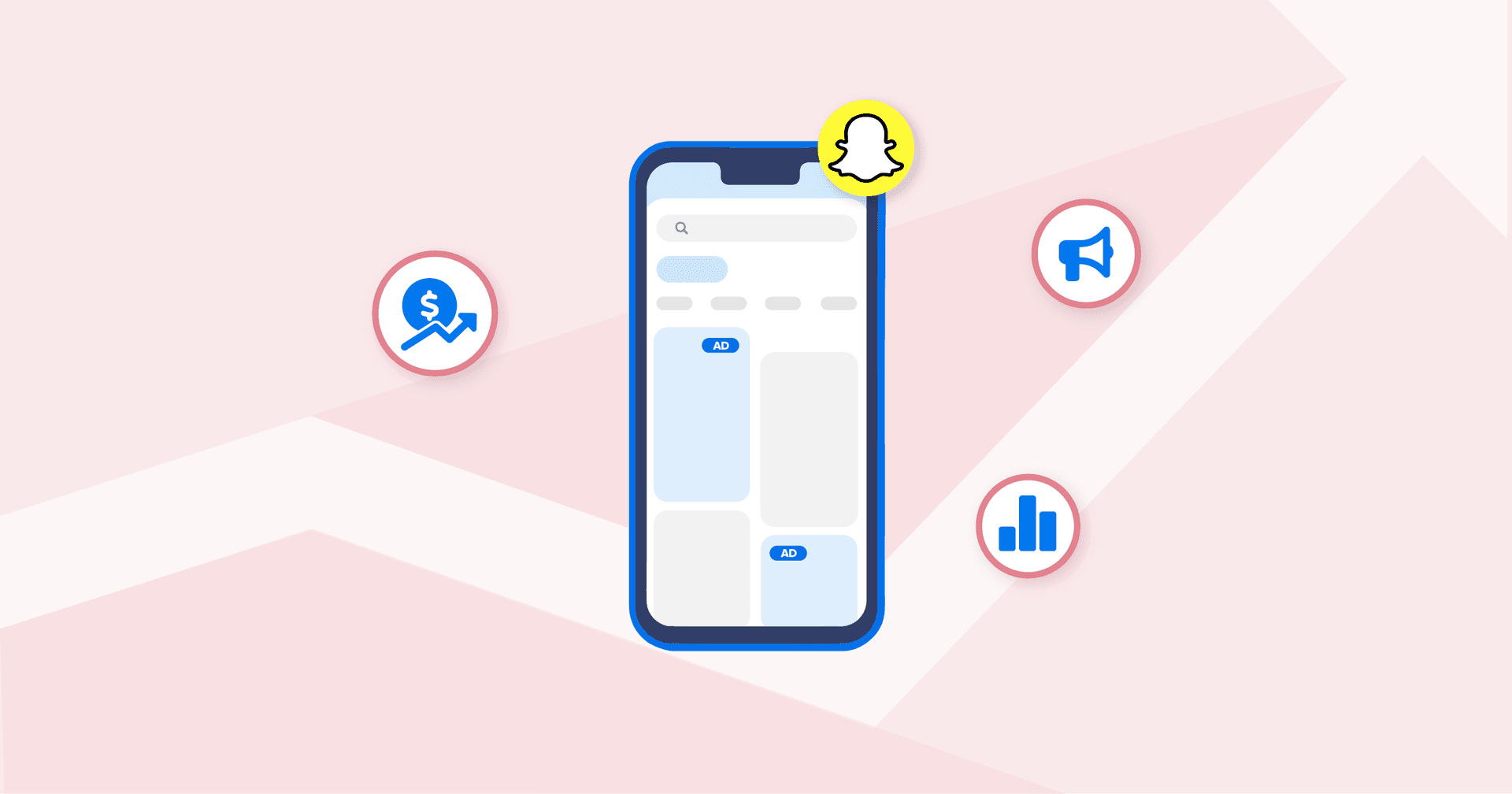Table of Contents
QUICK SUMMARY:
Client onboarding equips agencies and clients with the essential information and resources for successful collaboration, enhancing client satisfaction, and fostering long-term relationships. This new client onboarding process aligns clients with agency deliverables and expectations, ensuring clarity on service value, project timelines, and outcome assurance. This guide offers strategies to streamline client onboarding for marketing agencies.
Onboarding new clients can be complex and often daunting, especially when your team is juggling multiple projects, tools, and stakeholders. A structured client onboarding process cuts through that chaos—it turns a fragile first impression into a predictable, repeatable way to deliver a great customer experience.
Done well, a successful customer onboarding process does three big things at once: it reassures new customers that they chose the right agency, gives your team all the information they need to execute, and reduces the human error that creeps in when onboarding lives in random email threads and spreadsheets.
Getting new clients is great, but as we grow, onboarding can be so time-consuming. I look forward to having the onboarding over and a return to a normal work schedule.
Linda Rooney, Founder + CEO, DandeLions Digital
The first impression you make on a new client shapes how they see your agency—and how long they stick around. A good client onboarding process sets expectations, maps out communication, and shows exactly how you’ll help them grow revenue over time.
In this guide, we’ll walk through what client onboarding is, popular strategies, and a 10-step client onboarding workflow tailored to agencies. You’ll also get client onboarding best practices you can turn into your own onboarding checklist, onboarding questionnaire, and repeatable SOPs.
What is client onboarding?
Client onboarding is the structured process you use to welcome a new client into your agency, collect information, and set the foundation for your future relationship. It’s the bridge between the sales process and day-to-day delivery—and it applies whether you’re onboarding new clients, new users of a platform, or an entirely new customer segment.
Jennifer Bourn from Bourn Creative summed up their process:
New clients acquire the necessary knowledge, understanding, and tools needed to be a good client. A service provider or team acquires the necessary knowledge, understanding, and tools needed to be a good service provider.
In other words, a good onboarding process gives your client everything they need to work with you confidently, and your team everything they need to deliver. A streamlined customer onboarding process also improves data collection (instead of chasing details later), reduces human error, and creates more satisfied customers who become advocates and fuel word of mouth marketing.
The ultimate goal of a solid onboarding process is simple: both you and the client should walk away on the same page about deliverables, timelines, responsibilities, and what success looks like.
Popular onboarding strategies
How you design your client onboarding process depends on your services, team size, and the type of client relationship you’re building. There’s no single “right” way—what matters is that your onboarding processes are intentional, repeatable, and easy for both you and the client to follow.
Here’s a quick comparison of the most common client onboarding strategies agencies use today, along with high-level pros and cons.
Onboarding Strategy | PROS | CONS |
|---|---|---|
One-on-One Onboarding | Personalized attention and tailored solutions to individual needs. Opportunity for deep understanding and analysis. | Time-consuming and resource-intensive. Challenging to scale. |
Group Onboarding | More efficient and less time-consuming. Allows for collaboration and team-building. | Lacking the personalized attention some clients need. Difficult to address individual needs. |
Self-Service Onboarding | Convenient and scalable. Allows for individual pacing and flexibility. | Lacks the personal touch and guidance of one-on-one or group customer onboarding. Requires more upfront planning. |
Hybrid Onboarding | Combines the best of all worlds, offering personalized attention, group collaboration, and self-paced learning. Scalable and adaptable. | May require more resources to plan and implement. Can be more difficult to manage. |
Why the onboarding process for new clients is essential for long-term success
Your client onboarding process sets the tone for your future relationship with a new client. A thoughtful customer onboarding sequence makes clients feel like they’re in safe hands; a scattered approach creates friction, confusion, and doubt.
There's a vast difference between the two—that difference significantly impacts your agency's reputation and your customer lifetime value, which is one of the most important client retention KPIs.
The onboarding process for new clients also gives you a chance to talk with each client and thoroughly understand their expectations and goals. A client relationship that doesn't have clear expectations is doomed for failure, so make sure to set expectations in terms of deliverables and timeline upfront.
For example, positions reported in SEO rankings tools typically don't jump to page one overnight, and your client needs to understand the timeframe and scope of the project.
Our client onboarding questionnaire collects all the essential info you'd expect to have on hand before speaking with them. In addition to the basics, we always like to get a feel for the bigger goals and ambitions that have brought the discovery session about. At this stage in the journey, we are less concerned with the marketing numbers, and more concerned with the big picture - what does the client want to achieve, and most importantly, why.
James Londesborough, Owner / Managing Director, Ignite Marketing
When onboarding goes well, both sides have clearly defined shared goals, understand the scope, and know what happens next. That clarity not only prevents scope creep and technical issues later, it also improves the overall customer experience and makes it more likely that clients refer you to others.
In other words, client onboarding helps you just as much as it helps the client.
10 essential steps to ace client onboarding (+ a client onboarding checklist)
To ensure a seamless and efficient process, we've outlined ten crucial steps to follow when onboarding clients at your marketing agency. By implementing these guidelines, you'll be well-equipped to create lasting impressions and foster strong relationships with your clients.
Step 1: Send a clear welcome email (and confirm the signed contract)
A good client onboarding process starts the moment the customer signs the contract—not weeks later. As soon as the deal is closed, send a clear, friendly welcome email that:
Confirms that the signed contract has been received
Thanks them for choosing your agency and sets expectations for next steps
Re-shares key contact details and your primary point of contact
Links to any essential documents or a simple welcome package (e.g., onboarding guide, FAQs, or a link to your client onboarding questionnaire)
Each welcome email should tell new clients exactly what happens next and when. That way, you onboard new clients on the right foot, avoid early confusion, and reduce the number of “just checking in” messages before the first kickoff call.
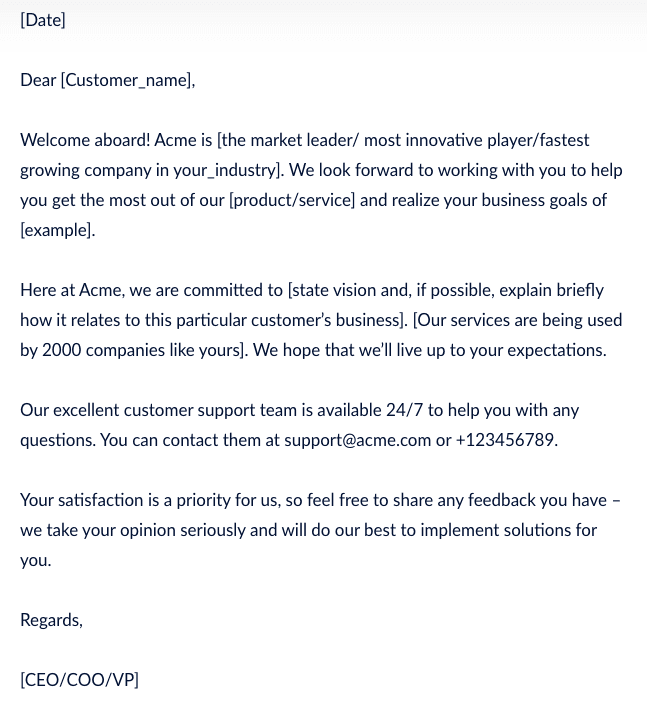
A sample welcome letter from acquire.io
As you welcome the client and move through the client onboarding process, keep your records up-to-date. Save a copy of any communications you send to the client, and add any new information you get to your CRM system right away.
Step 2: Use a client onboarding questionnaire to collect information
There are several ways to collect information—intake forms, emails, discovery calls—but scalable agencies lean on a repeatable client onboarding checklist and questionnaire. It reduces human error, keeps all the information in one system, and means your onboarding team doesn’t have to start from scratch with every new customer.
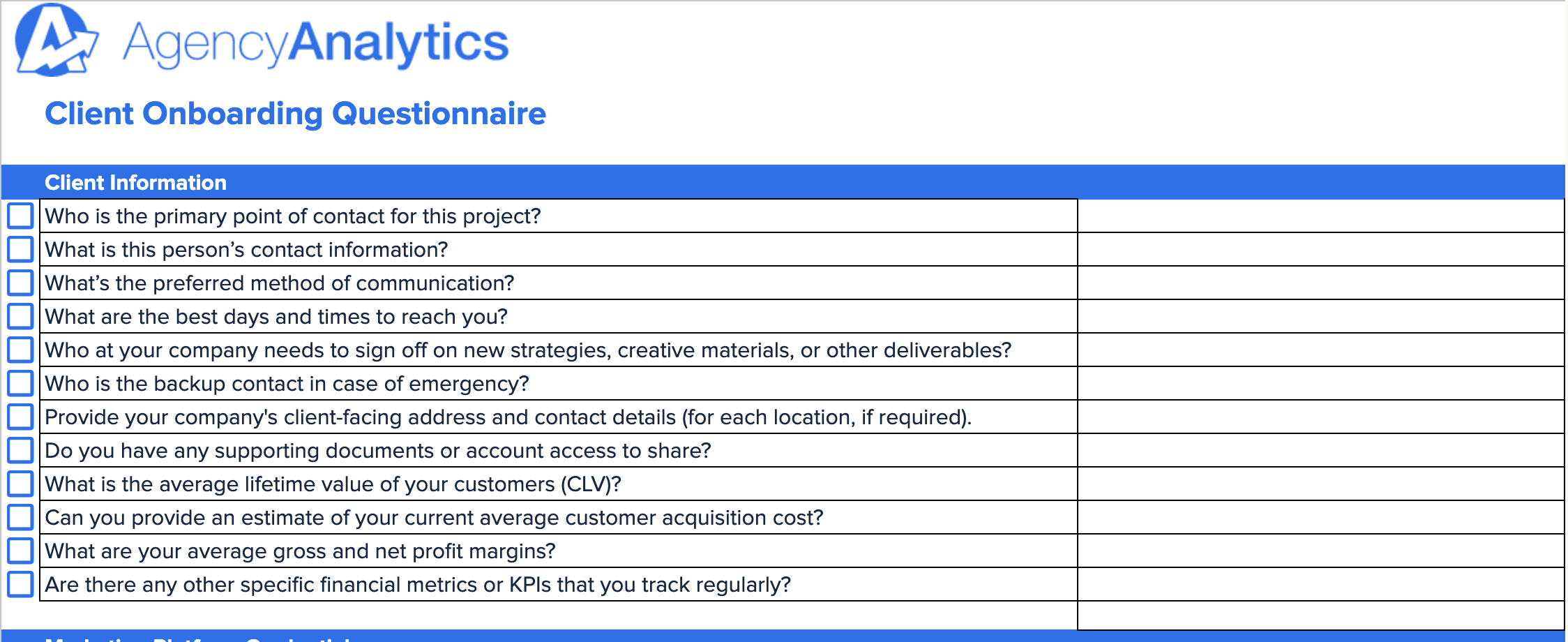
No one likes filling out forms, but if your client understands why this is a crucial step, they'll be more likely to give you valuable and thorough information.
Emphasize that you'll be able to help them most effectively if they give you a good window into the inner workings of their business, as well as their thought processes and goals.
So which questions should you ask? That depends on your services, but most agencies use the onboarding questionnaire to cover:
Business vision and goals – What is the client’s company trying to achieve in the next 12–24 months? How do they define success?
Audience and positioning – Who are their best customers today? What problems do they solve? What makes them different from competitors?
Current marketing and content creation – What channels are already in use? What’s worked, what hasn’t, and how are they generating leads or sales now?
Communication preferences – Who is your primary contact, and who else should be involved in a kickoff meeting or kickoff call? How often do they want to check in?
This level of detail turns a one-off discovery chat into a repeatable customer onboarding process your whole team can rely on.
Step 3: Assign an account manager or point of contact
Every new client should know exactly who owns the relationship on your side. Assign an account manager (or equivalent role) to lead the onboarding process, coordinate internal work, and handle the client’s questions. A single primary contact simplifies communication, creates accountability, and makes the experience feel more personal.
Without a clear owner, new clients end up chasing different people for different answers, and your team spends more time forwarding messages than solving problems. A dedicated account manager keeps the onboarding client experience organized and reduces the risk of delays or crossed wires.
Step 4: Get your entire team on board
Onboarding extends beyond the client; it also applies to your internal team. New employees and existing staff alike should understand the client’s background, goals, and scope of work. A clear internal onboarding process makes it easier for anyone on the team to step in without missing context.
Organize a brainstorming session that brings everyone involved in the new client’s projects together. Encourage your team to generate many ideas and strategies to help clients reach their goals. This collaborative approach fuels creative inspiration and fosters a deeper understanding of the client’s business.
Step 5: Schedule an onboarding meeting
Once you’ve gathered the initial information, schedule a formal kickoff meeting (or kickoff call) with your new client. Invite clients to a kickoff where you walk through the plan together, confirm priorities, and make sure everyone is truly on the same page.
During the meeting, delve deeper into the client's goals, needs, and expectations. Utilize this opportunity to clarify any ambiguities and address all crucial aspects. Look for S.M.A.R.T or M.A.S.T.E.R goals that can help structure and help both your client and your employees understand priorities. Preparing a list of discussion points beforehand helps keep the conversation on track and ensure no critical details are overlooked.
This initial meeting also serves as a platform to acquaint the client with your agency's working style. Elaborate on your methodologies, capabilities, and any limitations. Communicate your expectations regarding collaboration and communication, fostering a transparent and productive relationship. Ensure that you, the client, and key team members all have a common understanding regarding the projects you'll be collaborating on.
Together, establish project timelines, milestones, and deadlines. Confirm that both parties understand the criteria for measuring success, which includes an overview of the client's priority metrics and KPIs.
If possible, identify a few realistic quick wins you can highlight during this first meeting—small but meaningful early results that build trust while longer-term work ramps up.
When we onboard our new partners, we show them a full live example of the reporting and how easy it is to view real live data all in one place. This is definitely a winning experience for us and our partners. They understand that they are also saving time by be able to view all these important metrics all at once.
Justin Hual, Co Founder + COO, HIP Creative
Here’s an outline of a typical marketing agency onboarding agenda that is perfect as a starting point.
Topic | Discussion Points |
|---|---|
Client Background and Goals | Client's industry and target audience Client's business objectives and priorities Short-term and long-term goals |
Project Scope and Expectations | Project deliverables and outcomes Client's expectations and requirements Agency's role and responsibilities |
Communication and Collaboration | Preferred communication channels Response time expectations Meeting schedules and cadence Ongoing communication preferences |
Account Management and Team Members | Introduction to the account manager or point of contact Introduction to key team members Roles and responsibilities of team members Access and logins for multiple tools |
Budget and Payment Terms | Project budget and payment structure Billing cycle and payment terms Any additional fees or expenses |
Timelines, Milestones, and Deadlines | Key project milestones Deadlines for deliverables Overall project timeline |
Measuring Success and KPIs | Key Performance Indicators (KPIs) Metrics for measuring success Reporting frequency and format |
Potential Challenges and Solutions | Identification of potential challenges Strategies for addressing challenges Contingency plans |
Next Steps | Immediate action items Project kick-off date Follow-up meetings and communication schedule |
Step 6: Set expectations early and clearly
When both parties have a mutual understanding of project goals, timelines, deliverables, and responsibilities, it lays the groundwork for a harmonious partnership and helps avoid misunderstandings, crazy client requests, general scope creep, and disappointments down the road.
Clear expectations are just as important for your internal onboarding team as they are for the client—everyone needs to know who does what, when to check in, and how success will be measured.
Here are five key reasons why setting expectations is vital during the client onboarding process:
Aligning goals and objectives: Communicating expectations from the outset ensures that both the agency and the client are working towards the same goals. This alignment is essential for achieving the desired outcomes and maintaining client satisfaction.
Effective resource management: When expectations are set early, marketing agencies better allocate resources, such as time, budget, and staff, to meet client needs. This proactive approach helps prevent last-minute surprises or resource shortages from jeopardizing project success.
Accountability and transparency: Establishing clear expectations provides a basis for accountability and transparency between the agency and the client. When everyone understands each other’s roles and responsibilities, tracking progress, addressing concerns, and maintaining open communication is easier.
Conflict prevention: By discussing project scope, timelines, and deliverables in advance, both parties identify and address any discrepancies or concerns before they escalate into larger issues.
Trust building: Clear communication of expectations during the client onboarding process helps build trust between the agency and the client. When new clients feel that their expectations are understood and met, they are more likely to view the agency as a reliable and trustworthy partner, which fosters long-term relationships.

AgencyAnalytics offers customizable marketing dashboard templates to keep clients up-to-date on KPIs
To set expectations effectively during client onboarding, marketing agencies should:
Engage in open and honest dialogue with new clients about their goals, needs, and preferences
Provide a detailed project scope, including timelines, deliverables, and budget allocations
Clearly outline roles and responsibilities for both the agency and the client
Establish a communication plan that includes regular progress updates and check-ins
When we're onboarding a client, we ask what their KPI's are, then we ask them to help us connect their accounts to our system. We show them what we're going to track, how we're going to track it, and what they can expect.
Ruben Roel, President, Investigator Marketing
Step 7: Establish preferred methods of communication
By identifying and implementing communication channels that cater to each client's unique preferences–as well as the marketing agency’s capability–it’s that much easier to foster an environment of collaboration, trust, and transparency that is essential for long-term success.
Keep in mind that this process is a two-way street. You need to find a communication method that works for the client AND the agency. After all, it’s inefficient for your team to work with one client on Discord, another on Slack, a third on WhatsApp, etc.
The best client onboarding processes document these preferences once, so your team doesn’t have to relearn communication habits every time a new customer joins.
Agency Tip: Integrated client messaging is just one of the client onboarding and relationship management features available on AgencyAnalytics. With this, agencies chat with their clients from one streamlined and comprehensive reporting platform.
There are definitely some compelling reasons why establishing preferred methods of communication is crucial during client onboarding. Here are five of them:
Enhanced collaboration: By using communication channels that both parties find convenient and efficient, marketing agencies ensure smoother client collaboration. This allows for more effective sharing of ideas, feedback, and progress updates, ultimately leading to better project outcomes.
Improved responsiveness: When agencies and clients communicate through preferred methods, response times are quicker, as both parties are more likely to engage in the conversation actively. This leads to faster decision-making and issue resolution, which is crucial for keeping projects on track.
Strengthened relationships: Establishing preferred communication methods demonstrates that a marketing agency is attentive to its clients' needs and preferences. This tailored approach helps build rapport and trust, laying the foundation for a strong and lasting relationship.
Increased efficiency: By streamlining communication through preferred channels, marketing agencies minimize disruptions and reduce the likelihood of information being lost or overlooked. This ensures that all parties have access to the information they need when they need it, ultimately boosting productivity.
Greater client satisfaction: When new clients feel heard and understood, they are more likely to be satisfied with the agency's services. By catering to their preferred communication methods, marketing agencies enhance client satisfaction and improve client retention.
To establish preferred methods of communication during client onboarding, marketing agencies should:
Consult with new clients to understand their communication preferences and limitations
Provide multiple communication options, such as email, phone calls, video conferences, and messaging platforms
Clearly outline communication protocols, including response time expectations and points of contact
Regularly evaluate the effectiveness of the chosen communication methods and make adjustments as needed
By prioritizing the establishment of preferred methods of communication during client onboarding, marketing agencies create a positive and productive environment that fosters successful partnerships and drives business growth.
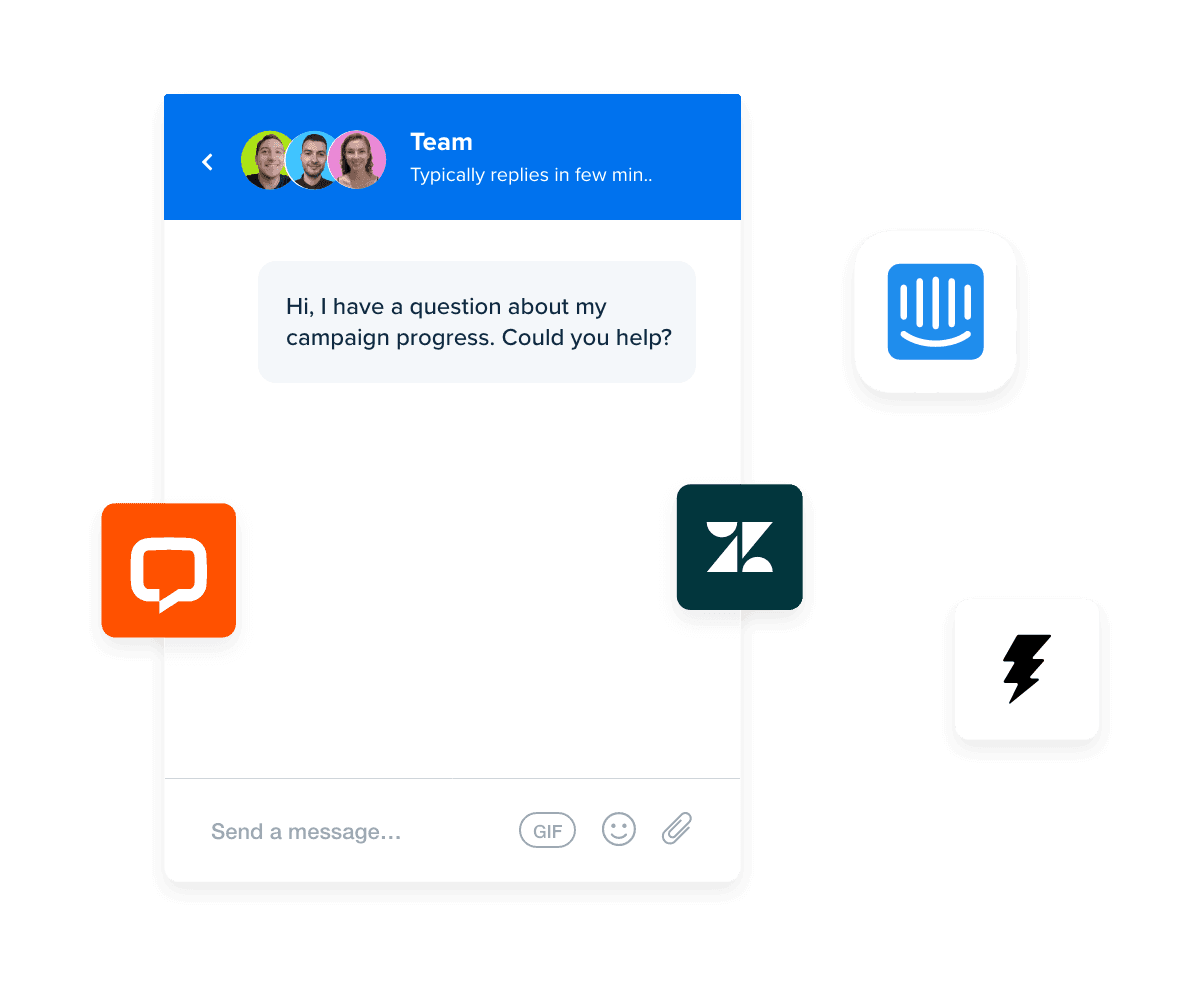
Integrate your client messaging tool with AgencyAnalytics for a seamless agency communication experience. Get started today with a 14-day free trial.
Step 8: Set a meeting and reporting cadence
A well-defined meeting and reporting cadence provides new clients with a clear picture of how often they will receive updates on the project's status, deliverables, and overall performance.
This transparency helps set expectations, reduces the requirement for ad-hoc reporting, and builds trust between the agency and the client, as it demonstrates the agency's commitment to delivering results and keeping the client informed.
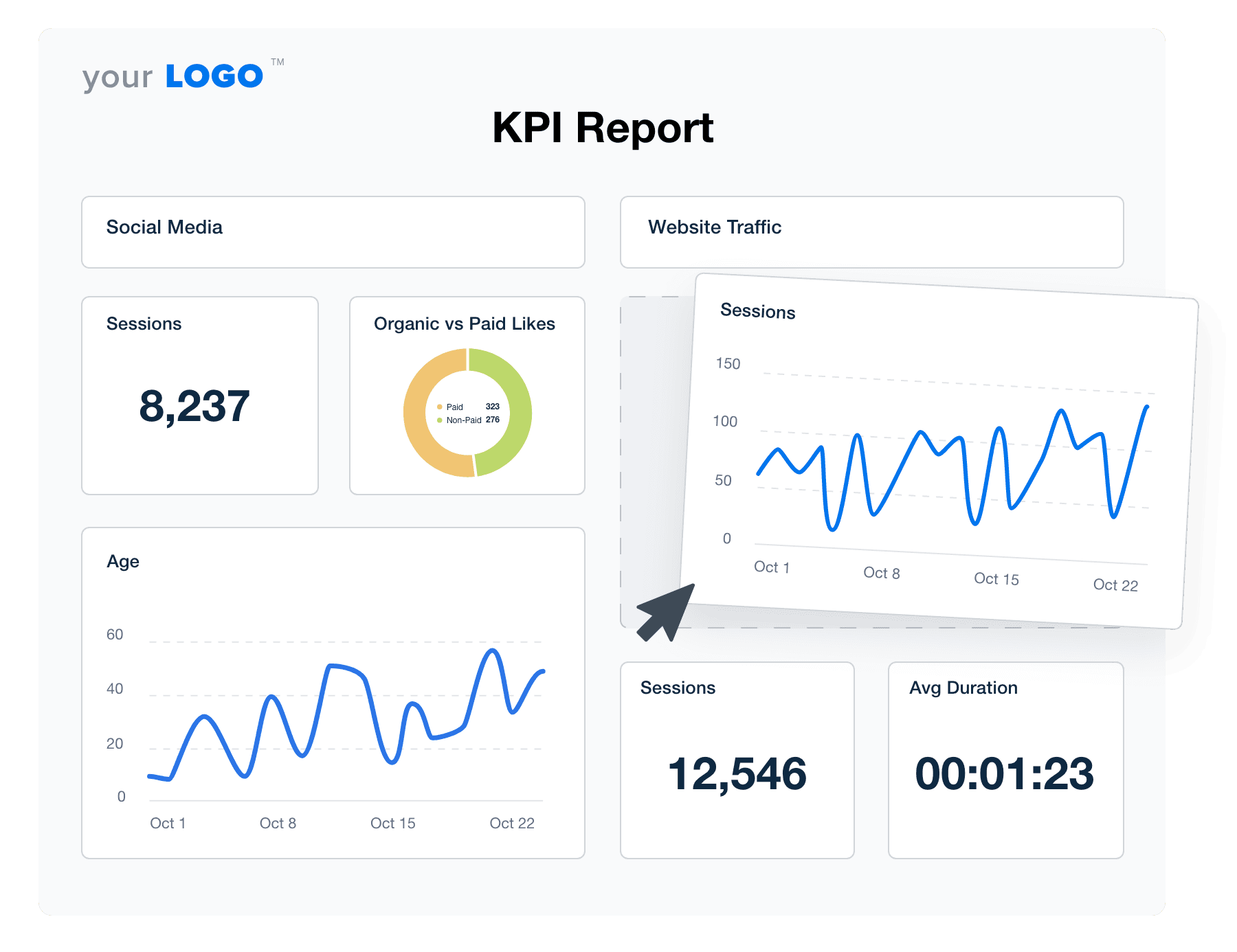
Regular check-ins are great because they provide a scheduled opportunity for the client to ask questions, provide feedback, and make adjustments as needed, ensuring that the project stays aligned with their expectations and objectives.
Moreover, a consistent meeting and reporting schedule helps to create a sense of accountability for both parties. The agency's team members know they must deliver updates and progress reports at set intervals, encouraging them to stay focused and meet their deadlines.
On the other hand, clients are more likely to actively participate in the project and provide timely feedback when they know they will be engaged regularly.
This shared sense of responsibility fosters a collaborative environment where both parties work together to achieve the desired outcomes.
When your meeting cadence and reporting rhythm are set early, every check-in feels intentional instead of reactive.

Simplify your client onboarding process by scheduling the automatic delivery of client reports. Choose from daily, weekly, bi-weekly, monthly, or quarterly intervals to ensure your clients are kept up-to-date and informed.
Step 9: Create a reporting system that works
Setting up the reporting systems is essential to the client onboarding process. This helps your agency provide the client with the data that they need, and–done properly–it’s streamlined in such a way that it provides added value without taking up too much time.
We start with a template for our new clients, and during their onboarding, we ask what their top KPIs are. We make sure to include those on the first page for them. As we have our first few strategy meetings, we take a look at these reports and ask our clients about their reports, and make edits to the templates with our clients as another customization tool.
Christina Cypher, Director of Marketing, Click Control Marketing
If you're looking for a way to cut down on the time you spend creating reports for your clients, marketing dashboards make it easy to customize reports for each of your clients, so their live marketing metrics populate on their own. Plus, you can clone an entire client setup with just a few clicks!
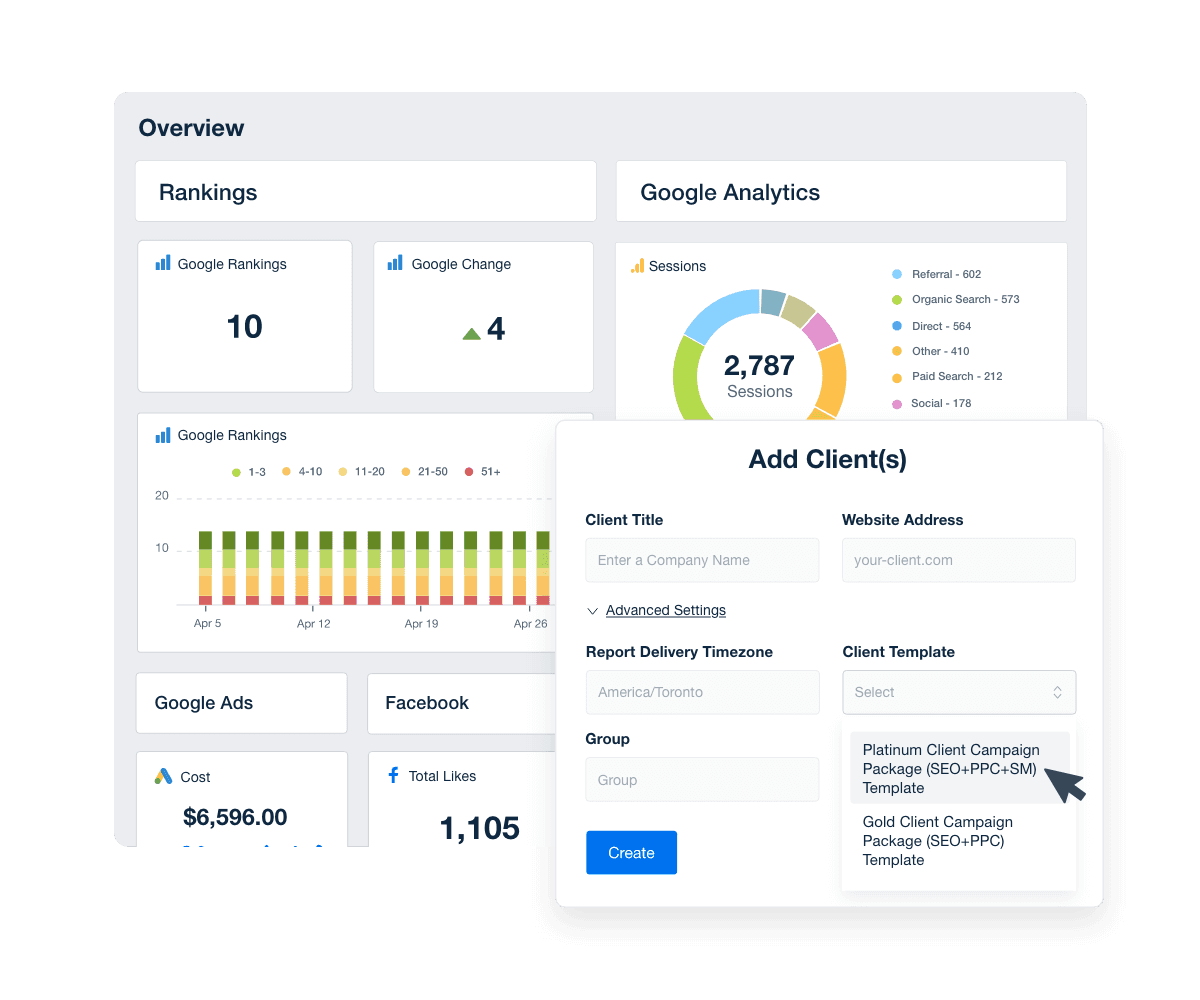
You only need to write a simple executive summary at the beginning of each report. This creates a more transparent and personalized approach with your clients and saves you hours of unproductive time each month.
Step 10: Follow up, collect feedback, and improve
our client onboarding process doesn’t end after the first meeting. To create a truly successful customer onboarding process, you’ll need to follow up, listen carefully to the client’s questions, and adjust anything that isn’t landing quite right. After some time has passed, send them a follow-up call or email. Ask how they like working with your agency, whether they’ve experienced any problems, and whether they have any new questions for you. If they do have questions or concerns, do your best to resolve those immediately.
Regular feedback loops provide valuable insights into what is working well, what needs improvement, and how the agency can better meet the client’s needs.
By promptly addressing any concerns or issues, the agency demonstrates its commitment to delivering exceptional service and ensuring the client’s success. This adaptability and responsiveness help to build trust and establish the agency as a reliable and attentive partner.
It’s usually best for this to happen 1:1 between the account manager and main point of contact at the client rather than during the regularly scheduled check-in meetings (where more team members may be involved). The client may not feel comfortable expressing concerns about the team, or the quality of the deliverables, in front of a larger group.
Generally, it’s good to follow up with a client two weeks to two months after your first meeting. When clients feel heard and understood, they are more likely to be satisfied with the agency’s services and view the relationship as a collaborative endeavor.
These early conversations lay the groundwork for a strong ongoing relationship, not just a successful launch.
How to improve your marketing agency’s client onboarding process
A seamless and efficient customer onboarding experience not only sets the stage for successful collaborations, it also establishes your agency as a leader in your niche. But building a truly good client onboarding process takes iteration, feedback, and small improvements over time.
In this section, we will explore proven strategies and best practices to enhance your agency's client onboarding process, ensuring that you consistently deliver exceptional service that exceeds client expectations
Assess your agency’s current client onboarding flow
Before making improvements to your marketing agency's client onboarding process, you need to know what to fix within your current approach.
Take the time to map out each step of the customer onboarding journey, from initial contact to project launch. Identify potential bottlenecks, pain points, and areas for improvement. Solicit client and team feedback to gain valuable insights into their experiences and expectations.
Map out the full client onboarding process flow visually if you can; seeing every touchpoint in one place often reveals redundant onboarding activities or gaps you’d otherwise miss.
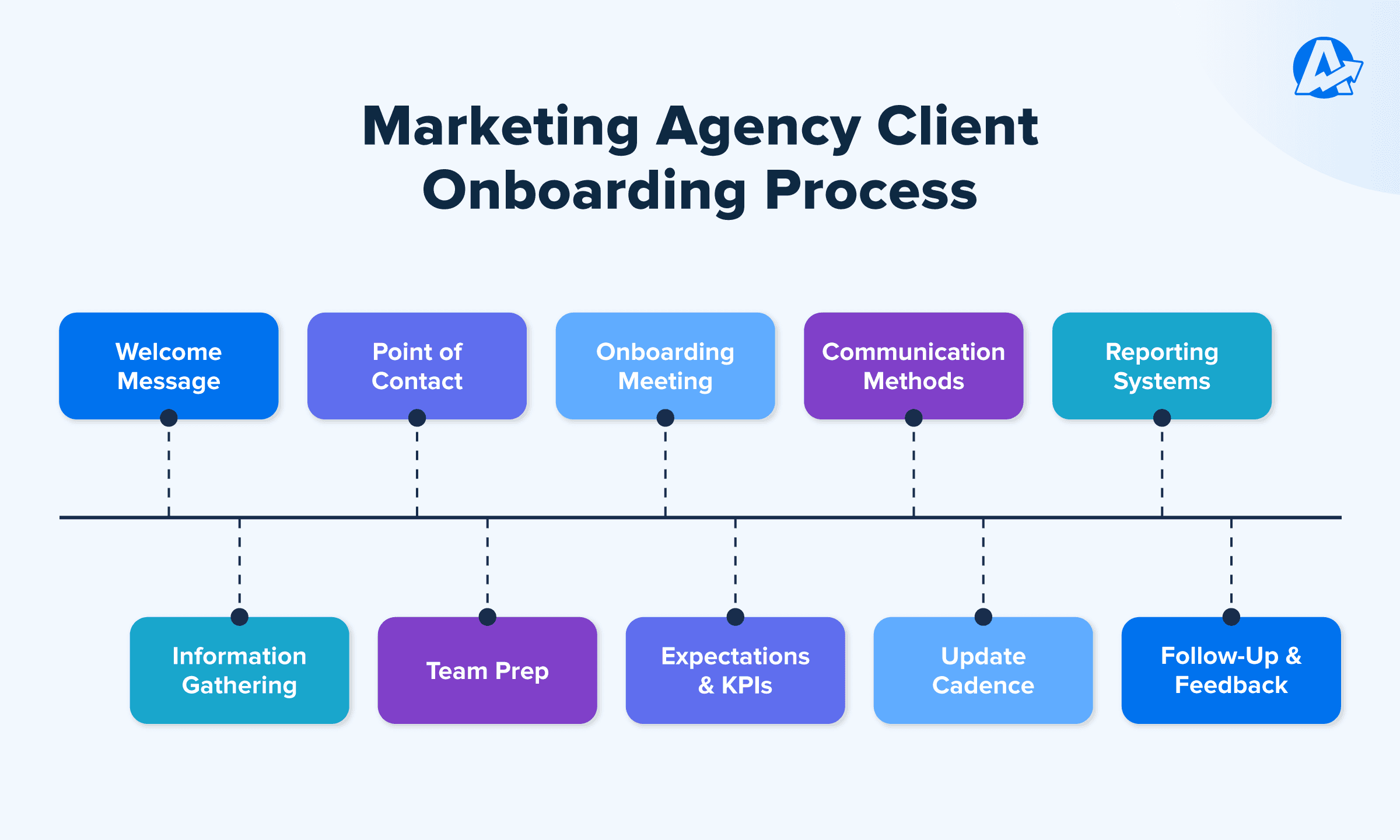
This comprehensive assessment provides a solid foundation for developing a targeted strategy to enhance your agency's customer onboarding process and–eventually–create a repeatable client onboarding checklist to follow.
Develop a comprehensive client onboarding plan
Using what you discovered in the assessment above, outline each step of the new and improved customer onboarding journey, clearly defining tasks, responsibilities, and deadlines for both the agency and the client.
This plan should include when and how to set expectations, ways to establish communication channels, assigning an account manager, and conducting initial strategy meetings.
Establish effective communication channels
Choosing the right communication tools and channels can make or break an agency/client relationship. But you don’t want it to be the Wild Wild West of touchpoints, so focus on selecting platforms that enhance your agency's efficiency while accommodating the new client's communication preferences.
Start by reviewing the available options, such as email, phone, video conferencing, and messaging apps, and determine which tools best suit your agency's workflow and the specific project requirements.
Once you’ve established the baseline tech stack for communication tools, discuss these with the client and offer options that cater to their preferences. Would they prefer to email their questions, hop on a call or video conference, or DM their point of contact?
By striking the right balance between your agency's efficiency and the client's communication needs, you build a strong foundation for collaboration.
Personalize the client onboarding experience
Every client is unique, and your marketing agency's own onboarding process should reflect that. Personalize the customer onboarding experience by understanding the client's needs, goals, and preferences.
Tailor your approach to suit their industry, company size, and target audience. After all, the client onboarding experience should be different for Joe’s Plumbing, where your point of contact will always be Joe, versus ACME widgets, with a team of 6 marketing managers who are each responsible for one piece of the campaign pie.
Leverage technology and tools
We already discussed this when reviewing communication platforms, but utilizing the right technology and tools significantly enhances your agency's client onboarding process–and the long-term client relationship.
Consider implementing project and task management software, client reporting portals, and collaboration tools to streamline communication, track progress, and share important information.
The right tools also reduce manual data collection and duplicated effort, so your onboarding team spends more time building relati
When we're onboarding new clients, there's a huge checklist of tasks to go through: getting access to or creating ad accounts, websites, Google Analytics properties, Google Search Console, and more, formulating a strategy, setting up conversion and event tracking, etc.
You know the drill. It's a tedious and lengthy process. With AgencyAnalytics, the step for implementing reporting is a snap. Because you can create reports with just a few clicks, that whole process is effortless and anyone on the team can do it.
Graham Lumley, Director of Growth Marketing, Blackhawk
With a little help from technology, your marketing agency can transform into an efficiency powerhouse, making client onboarding feel as smooth as butter and–ultimately–delivering results that'll have clients singing your praises.
Continuously evaluate and refine the client onboarding process
Improving your marketing agency's client onboarding process is ongoing. Regularly evaluate the effectiveness of your approach, using client feedback and internal assessments to identify areas for improvement.
Adjust and refine your client onboarding process, incorporating new best practices, technology, and insights. By continuously evaluating and refining your approach, your marketing agency stays ahead of the curve, ensuring an exceptional customer onboarding experience that fosters lasting client relationships.
After all, you’ve done all that hard work creating a stunning SEO proposal, putting together a beautiful agency pitch deck, and overcoming a series of sales objections in an effort to get more clients. You don’t want the client onboarding process to fumble them right before the end zone. Yup, that was a sports reference right there!
Develop clear and concise client onboarding documentation and training materials
This is particularly important for marketing agencies with larger teams. It can be difficult for a single person–such as the agency owner or CEO–to handle all aspects of a good onboarding process.
By creating well-designed documentation and training materials, including a collection of report templates, you ensure that all team members are equipped with the necessary information and tools to onboard new clients effectively.
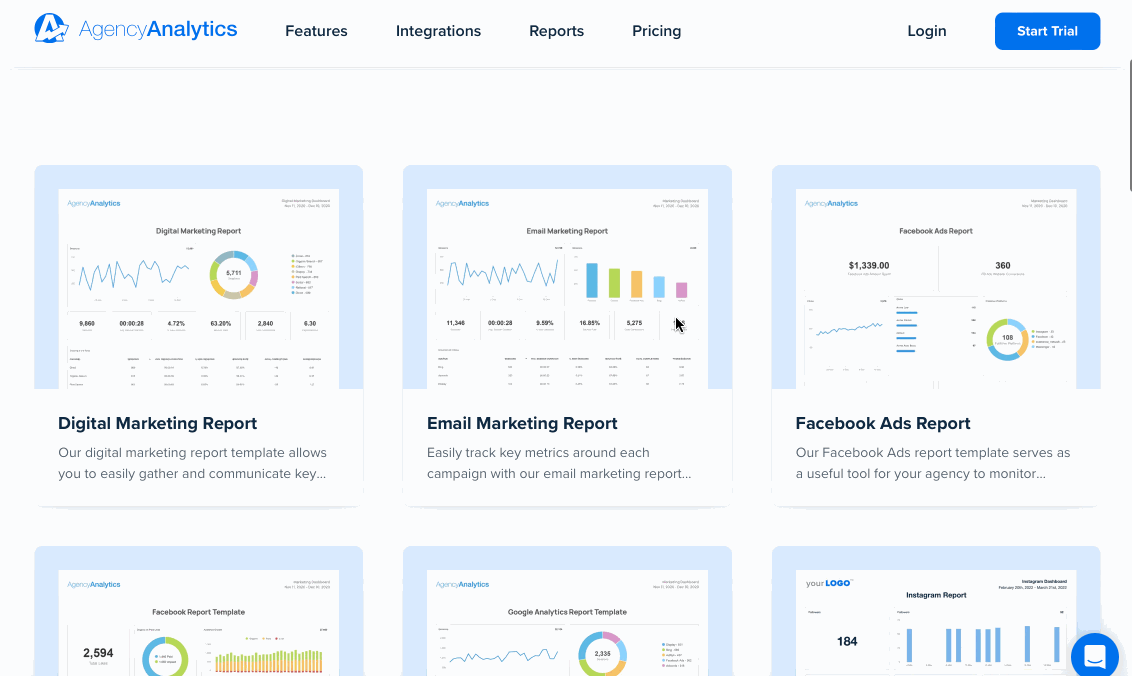
Just a few of the most popular templates used by agencies on the AgencyAnalytics platform include:
This not only helps to distribute the workload and avoid burnout, but it also ensures that clients receive a consistent customer onboarding experience, regardless of who is leading the process.
Our new and improved reporting process is a slam-dunk, outta-the-park home run, hat trick after hat trick, the very best thing we've done for our agency since we signed up earlier this quarter. It's so easy to use that my team can create report drafts for new client onboarding without live training with me.
Lisa Cutter, President, Vertical Insight Marketing
Clear and concise documentation also helps minimize confusion and errors during the client onboarding process. When multiple people are involved in customer onboarding, details can easily get lost or miscommunicated.
In addition, well-designed training materials help team members feel more confident and prepared to handle a solid onboarding process.
Impress clients and save hours with custom, automated reporting.
Join 7,000+ agencies that create reports in under 30 minutes per client using AgencyAnalytics. Get started for free. No credit card required.
The takeaway
A good client onboarding process is one of the highest-leverage systems in your agency. It helps you start new relationships on the right foot, reduce churn, and turn new customers into long-term partners who trust your work and refer more clients over time.
Yes, building a successful customer onboarding process takes effort up front. But once you’ve documented the flow, created a client onboarding checklist, and standardized your onboarding workflow, each new client becomes easier (and more profitable) to onboard.
Remember, the first step isn’t delivering work—it’s collecting the relevant information that allows your team to execute with confidence. When clients see that your process is organized, thoughtful, and rooted in greater detail than they expected, they recognize the value of your agency immediately.
Your kick off call or kick off meeting reinforces this foundation. It’s where alignment happens, expectations become clear, and both sides confirm they’re moving toward the same goals.
To keep improving your onboarding over time:
Assess your current customer onboarding process – Identify bottlenecks, duplicated steps, and where new clients tend to get confused.
Develop a clear onboarding plan – Outline each step, from welcome email to kickoff meeting, reporting setup, and first check-in.
Set expectations early and clearly – Talk through goals, timelines, deliverables, and scope before the customer signs on the dotted line.
Establish effective communication channels – Choose tools that work for both you and the client, and document how and when you’ll communicate.
Personalize the experience – Use your onboarding questionnaire to adapt your approach to each client’s industry, size, and priorities.
Leverage technology and templates – Use project management, intake forms, and reporting tools like AgencyAnalytics to reduce manual work and keep everything up to date.
Create SOPs for your onboarding team – So you’re not the only person who can onboard new clients, and everyone follows the same best practices.
By following these guidelines, your agency’s client onboarding process evolves into a predictable, scalable system—one that strengthens relationships, drives retention, and ultimately leads to more clients through referrals and long-term trust.

Written by
Paul Stainton is a digital marketing leader with extensive experience creating brand value through digital transformation, eCommerce strategies, brand strategy, and go-to-market execution.
Read more posts by Paul StaintonSee how 7,000+ marketing agencies help clients win
Free 14-day trial. No credit card required.





